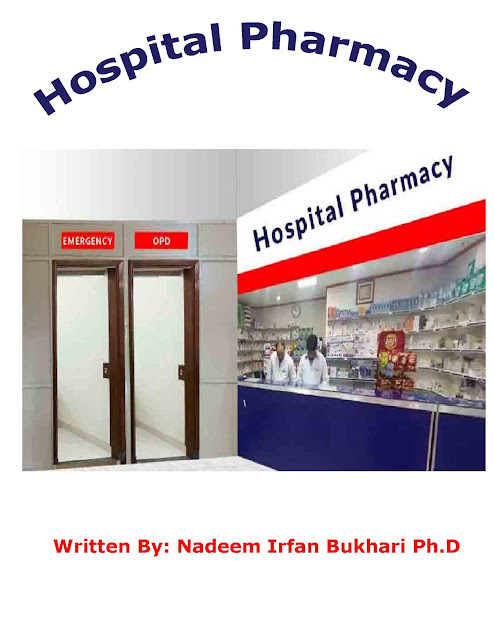Hospital Pharmacy Book is written by Nadeem Irfan Bukhari is available in pdf for free. Every one can download it without signup.
Hospital Pharmacy Nadeem Irfan Bukhari
In this book Hospital Pharmacy Nadeem Irfanhas written about Hospital Pharmacy Pratice.
Nadeem Irfan Bukhari
Prof. Dr. Nadeem Irfan Bukhari joined the University College of Pharmacy, University of the Punjab, Lahore in 2001. of Pharmacy and Islamia University of Bahawalpur, Bahawalpur. He previously worked as a radiopharmaceutical and hospital pharmacist at the Shaukat Khanum Memorial Trust Cancer Hospital & Research Center, Lahore.
At IMU and UCSI, he has also participated in pharmaceutical programs at the University of Strathclyde, Glasgow, United Kingdom, and Curtin University of Technology, Australia. He has published more than 88 research articles in journals on influencing factors and is a co-author of several professional books. As a member of the panel of experts of the Ministry of Public Health of the Government of Pakistan, he provides consultations on matters related to the pharmaceutical industry. He has lectured to international institutions including University College London, London, UK. He is a visiting professor at DeMont Fort University, Leicester, UK. His students earned PhD degrees from DeMont Fort University, University of Otago, New Zealand and University of the Punjab, Lahore. His research areas are: Pharmaceutical Technology, Nanotechnology, Liquid / Semi-Solid Matrix Technology, Artificial Intelligence in Formulation Design, Innovative Administration, Bioequivalence, Bioavailability, Pharmacokinetics, Pharmaceutical Statistics, PK-PD Modeling and Pharmacology.
Dr. Nadeem received a research scholarship to University College London, London UK. She has received a number of international research grants and sponsors from the IMU and the World Health Organization-Health Action International. He holds a B. Pharm and M.Phil from Gomal University, Dera Ismail Khan and the University of the Punjab, Lahore, each and a PhD from Universiti Sains Malaysia, Malaysia. Thanks to his performance during B.Pharm, he was awarded the Presidents Talent Scholarship. He remains a cartoonist whose work has been on display for about 10 years in leading national Urdu and English dairies. He write book Hospital Pharmacy Nadeem Irfan.
Supply Medicine
Drug delivery is part of a multidisciplinary process that begins with a prescription and culminates in the administration of a drug to a patient. Because almost every patient admitted to the hospital receives a drug in one form or another, the safe and secure administration of drugs is an essential part of the hospital's drug management system and is subject to the standards described in the trust registration requirements. their superior, such as the Care Quality Commission in England.1 Medicines management should therefore take place through policies, procedures, staff training and quality assurance measures.
Most National Health Service (NHS) hospital organizations take responsibility for each part of drug management in their medical policy. While the Chief Executive Officer has overall legal responsibility for any hospital activity, the Chief Pharmacist is responsible for ensuring that systems are in place that properly address all aspects of safe and secure drug management and is directly accountable to the Executive Board. for this purpose throughout the organization. He also emphasizes the role of the 'senior pharmacist' described in Duthie's revised report, which also provides guidance on the responsibilities of other medicines management professionals.
Quality Assurance
Quality Assurance of pharmaceutical products and services comes first. Patients rely on pharmacists to deliver drugs that are always safe, effective, and of adequate quality. Quality itself has a number of definitions: dictionary.com has 19 different definitions of quality, most of which provide a relatively subjective perspective, consistent comparison and are difficult to measure and measure 10: "meeting customer needs" .11 TQM is a management philosophy that includes all activities where the needs and expectations of customers and the community are met, thus achieving the goals of the organization; These goals can be achieved in the most accessible way by maximizing the potential of all employees for continuous improvement. This is a useful definition that applies to Hospital Pharmacy Nadeem Irfan services and aims to ensure that service objectives are fully organized to meet customer needs.
The third method for determining the quality that is most suitable for use on pharmaceutical products is the definition of "fitness for purpose" as used in pharmaceutical production for many years. The rules and guidelines for pharmaceutical manufacturers and distributors (often referred to as the Orange Guide because of the color of their packaging) state that the goal of production quality is to ensure that products are always manufactured and inspected to quality standards. intended use and as required by the marketing authorization decision or product specification. ”12 This definition can be used in a quantitative sense with quality parameters and limits located where each service or batch of products is tested and inspected for compliance. Examples are product specifications that include tests and service specifications that include quantitative service parameters, such as recipe latency.
Hospital Pharmacy Nadeem Irfan we study "Quality Assurance" is a term used in all arrangements that affect the quality of products or services provided. The Orange Guide defines it as "a general set of organized measures taken to ensure that medicines are of the quality required for their intended use" .12 In pharmaceutical production, it consists of two good manufacturing practices (GMP) and a QC. GMP is part of QA, which ensures that products are always manufactured and inspected to quality standards appropriate to their intended use. QC is part of GMP, which deals with sampling, specifications and testing and release of products for use. Sharp provides a detailed discussion of these concepts in its text on the quality of medical device manufacturing.





.webp)

%20Web%20of%20pharma%20.webp)


%20webofpharma.JPG)



